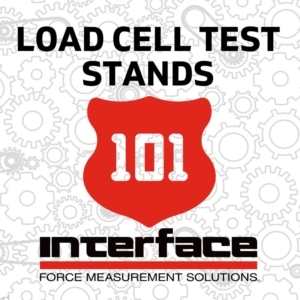Load Cell Test Stands 101
 Load cell test stands are important devices for manufacturers and testing engineers who need to measure the force or torque applied to an object, test specimen, or product. They are typically made up of a frame, one or more load cells, software, and data acquisition instrumentation.
Load cell test stands are important devices for manufacturers and testing engineers who need to measure the force or torque applied to an object, test specimen, or product. They are typically made up of a frame, one or more load cells, software, and data acquisition instrumentation.
How do load cell test stands work?
Interface load cells are sensors that convert force into an electrical signal. This signal is then amplified and sent to the test stand’s software, which displays and records the force data. The software can also be used to control the test stand, such as setting the speed and duration of a test.
Test stands are used to hold the test object or device and apply force or torque to it. They should be designed to provide a stable and consistent testing environment. It is typically designed to accommodate a wide range of objects of different sizes and shapes. Often a reconfigurable structure to adapt from test to test.
Test stands may have various components, such as a base or base plate, columns, a crosshead, and load introduction devices. Interface provides high-accuracy load cells, instrumentation and DAQ systems, software and accessories designed for use in various types of test stands.
What are the different types of load cell test stands?
There are two main types of load cell test stands: motorized and manual. Motorized test stands are more advanced and can be used for more demanding testing applications. They typically have features such as programmable speed and force control, as well as data logging capabilities. Manual test stands are less expensive and easier to use, but they are not as versatile as motorized test stands.
A test stand and a load frame are both mechanical structures used in materials testing, but they differ in their functions and designs.
The test stand can be a test bench or structure on a test bed plate. These assemblies are designed to rigidly hold an object while it is being subjected to external forces. These forces could be introduced from all angles and orientations and cover low cycle design limit to long duration fatigue cycle testing.
A load frame, on the other hand, is a machine that is specifically designed to apply and measure axial or torsion forces during material or small component testing.
Most Common Requirements for Load Cell Test Stands
Testing professionals, engineers and metrologists require a load cell test stand to perform accurate and precise measurements. The primary features of a test stand include:
- High accuracy: The load cell test stand must be able to measure force or torque with a high degree of accuracy. This is important to ensure that the measurements are reliable and repeatable. Confidence in the data must be validated through accuracy of measurement.
- Versatility: The load cell test stand must be able to be used for a variety of testing applications. Test lab professionals, engineers and metrologists need equipment that can perform a wide range of product and material tests. This also includes interchangeable sensors, depending on the capacity and type of test, such as tension or fatigue.
- Repeatability: The load cell test stand must be able to repeat measurements with high precision. This is important to verify the accuracy of measurements over time, through continuous use and even high cycle counts.
- Safety: The load cell test stand must be safe to use, even when testing products under high loads. Measurements are not compromised by safety concerns.
- Ease of use: The load cell test stand must be easy to use, even for users with limited technical knowledge. This is important for testing professionals to be able to quickly and easily set up and use the test stand.
Load cell test stand requirements can vary based on the type of testing projects and materials. Many test stands are standard; however, complex testing programs often require custom test stands that are designed and calibrated for specific use cases. Interface provide load cells, instrumentation and software designed for use in test stands.
Test Stand Sensor Considerations
- Ensure sensors are properly sized for capacity, cycle, and extraneous load considerations.
- Multiple bridges are good feature for redundancy and data validation.
- Thread adapters and connector protectors must be considered in choosing the sensor for a specific test stand application.
- Multi-axis data capture often requires robust instrumentation to take full advantage of the data.
- Invest in versatility and ruggedness to maximize return.
Additional Test Stand Options
- Programmable speed and force controllers help to regulate the rate at which the load is applied to the product, as well as the maximum force that can be applied during a given test period or cycle.
- Data logging instrumentation records the force data for each test. This data can then be used to analyze the results of the test and to make sure that the product meets the required specifications.
- Remote monitoring and controls help with test stand use from a remote location. This can be useful to run tests without being physically present at the test stand.
There are many different types of load cell test stands, so it is important to choose one that is right for your specific needs. When selecting or building a load cell test stand, consider the weight or force that you need to measure, the accuracy and precision, the environment in which the test stand will be used and the equipment budget. This is a topic we detailed in our Testing Lab Essentials Webinar. Watch this portion of the online technical seminar below.
Load Cell Test Stand Use Cases and Applications
- Aerospace test stands are used to measure the strength of aircraft structures. Test stands are used to test the performance and durability of aircraft components, such as wings, fuselages, and engines. They are also used to test the structural integrity of aircraft materials, such as composites and metals.
- Material test stands can be used to exam the strength, stiffness, and toughness of materials.
- Structural test stands are used for small capacity testing, as well as large amounts of force to measure the structural integrity of buildings, bridges, and other formations.
- Dynamic test stands are used to measure the performance of products under different environmental conditions, such as shock and vibration testing.
- Medical manufacturers need to test the performance of medical devices. Test stands are used to test the performance and durability of medical devices, such as pacemakers and defibrillators. They are also used to test the accuracy of medical instruments and in-home medical equipment, as the safety of user is paramount to all other requirements.
- Automotive labs use test the performance of engines, transmissions, brakes and other components. They are also used to test the durability of automotive materials, such as tires and plastics.
- Consumer product manufacturers and OEMs must test the durability to ensure customer satisfaction and reliability of the product. Test stands are used in testing toys, appliances, tools, and electronic devices.
- Industrial automation component makers and OEMs must test the strength of machine parts and materials used in product lines, machine tools, and robots. They are also used to test the safety of industrial equipment, such as forklifts and cranes.
Load cell test stands are an essential tool to accurately measure the forces acting on a test specimen. By using a load cell test stand, testing engineers can ensure that their equipment is operating within its design limits and that it is safe to use. If you have questions about building or upgrading your test stand, be sure to consult with our application engineers.








